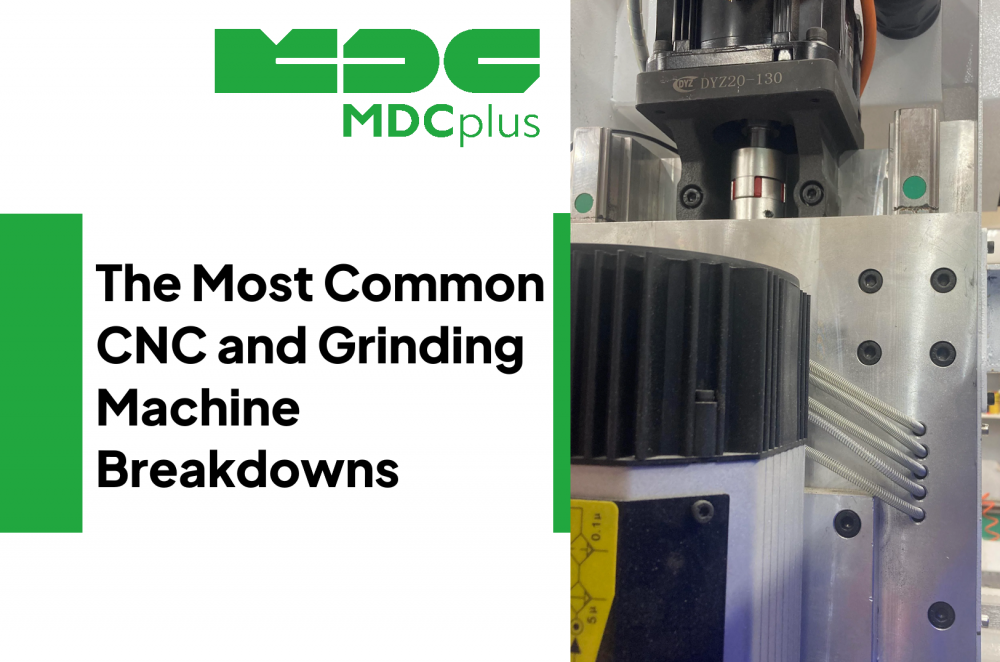Where Downtime Starts: The Most Common CNC and Grinding Machine Breakdowns
Some breakdowns are dramatic - a snapped spindle, a cracked grinding wheel. Others are quieter but more costly over time - like misaligned setups or worn tools pushed too far.
Understanding the most frequent sources of downtime is the first step to reducing it. Below, we break down the most common disruptions seen in CNC vertical machining centers (VMCs) and grinding machines, based on shop floor trends, maintenance logs, and operator feedback.
CNC VMC Breakdowns: What Stops the Spindle
Common sources of breakdown in vertical machining centers include:
- Tool breakage or excessive wear
- Setup errors (program, offset, or fixturing mistakes)
- Spindle overload or failure
- Coolant system faults
- Servo or encoder alarms
- Glass panel damage (windows or sensors)
- ATC (Automatic Tool Changer) malfunctions
- Pneumatic/hydraulic clamping issues
- Probe crashes or touchsetter faults
- Electrical/PLC issues
1. Tool Breakage or Wear
Tooling issues are the single most frequent cause of scrap and downtime. Dull or chipped tools lead to poor finish and dimensional inaccuracy. In worst-case scenarios, they break mid-cut, damaging the workpiece or even the spindle.
What makes this so common is that tools are often used slightly beyond their optimal life - not enough to fail instantly, but enough to compromise quality and add rework.
2. Setup Errors
Even experienced operators make setup mistakes: using the wrong work offset, loading an old program revision, or misaligning a fixture. These are preventable, but they happen frequently - especially in shops with high part variation or fast changeovers.
Small setup issues can lead to major downtime: ruined parts, machine crashes, or the need to restart a job entirely.
3. Spindle Overload or Failure
Spindle faults usually happen after a series of warnings - strange noises, vibration, or temperature spikes - but often go unnoticed until failure. Overloaded cuts, tool crashes, or lack of proper warm-up can contribute to shortened spindle life.
Repairing or replacing a spindle is not only expensive - it also means extended downtime, often days or even weeks.
Grinding Machine Breakdowns: When Precision Breaks Down
Grinding operations face their own set of challenges. Some issues overlap with CNC milling, but others are unique to the delicate and continuous nature of grinding.
Common disruptions include:
- Cracked or glazed wheels
- Setup or workholding errors
- Coolant system failure
- Wheel misbalance
- Spindle overheating
- Glass/ceramic part fracture
- Guard/door damage
- Slide stick-slip
- Control alarm lockups
1. Grinding Wheel Cracks or Dressing Problems
Wheels that aren’t dressed properly can glaze or lose form, causing vibration, poor finish, or part geometry issues. Worse, if a wheel is damaged during handling and goes unnoticed, it can crack during operation - a serious safety risk.
Regular dressing and proper storage are key, but many shops don’t track wheel condition systematically.
2. Setup and Workholding Errors
Just like in VMCs, improper setup leads to serious outcomes - especially in grinding, where tolerances are often tighter. If a part is clamped off-center, not seated correctly, or misaligned in height, the resulting taper or runout may ruin the part or worse - cause fractures in brittle materials like ceramics or glass.
Grinding machines often lack the probing tools found on CNCs, so careful manual setup is critical - and prone to human error.
3. Coolant Failure
Coolant in grinding isn’t just about temperature - it’s essential for wheel health and surface finish. Blocked nozzles, empty tanks, or misdirected flow can result in burns, loading, or thermal distortion.
Coolant problems are often small in appearance, but cause cascading quality issues that show up too late - sometimes after dozens of parts.
It Starts with Awareness
Machine failures can’t always be prevented, but most recurring downtime stems from predictable sources. Tool wear, setup errors, and poor maintenance habits are not exotic problems - they’re routine. That’s why they’re so dangerous.
Whether you're running five machines or fifty, tracking and addressing these common breakdowns is one of the fastest ways to protect uptime, reduce scrap, and boost shopfloor confidence.
Small improvements in setup discipline or tool monitoring can have an outsized impact - not just on cycle time, but on trust in your process.
About MDCplus
Our key features are real-time machine monitoring for swift issue resolution, power consumption tracking to promote sustainability, computerized maintenance management to reduce downtime, and vibration diagnostics for predictive maintenance. MDCplus's solutions are tailored for diverse industries, including aerospace, automotive, precision machining, and heavy industry. By delivering actionable insights and fostering seamless integration, we empower manufacturers to boost Overall Equipment Effectiveness (OEE), reduce operational costs, and achieve sustainable growth along with future planning.
Ready to increase your OEE, get clearer vision of your shop floor, and predict sustainably?
